Aluminium Design and Construction - Chapter 11 docx

Aluminium Design and Construction - Chapter 11 docx
... (per bolt) and on their condition. It is given by the expression: P – f =nµR – (11. 9) where n=number of friction interfaces and, µ=slip-factor (Section 11. 2.6). 11. 2.5 Bolt tension and reaction ... expressions in Sections 11. 1.4 and 11. 1.7, differ from those in BS. 8118 . The reason for not following the British Standard is that the stress values it employs seem inconsisten...
Ngày tải lên: 22/07/2014, 18:22
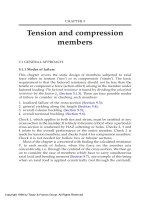
Aluminium Design and Construction - Chapter 9 docx
... general expression: (9.16) Figure 9.14 Four standardized profiles (BS. 116 1). Table 9.3 Properties of certain standardized shapes Notes. 1. The sections are standardized in BS 116 1. 2. For section details refer ... ‘Type-R’ sections In dealing with torsional buckling it is important to distinguish between ‘type-R’ sections and all others. A type-R section is one that consists entirely...
Ngày tải lên: 22/07/2014, 18:22
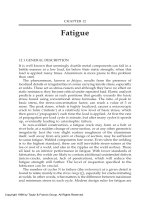
Aluminium Design and Construction - Chapter 12 ppt
... curve and the determination of the stress range. British Standard BS. 8118 fails to give guidance on the fatigue of bolts used in aluminium structures. 12.9.2 Endurance curves for steel bolts Aluminium ... structure than method (1). It is the approach most used in aircraft design. British Standard BS. 8118 does not cover the fail-safe method, and it is beyond the scope of this book....
Ngày tải lên: 22/07/2014, 18:22
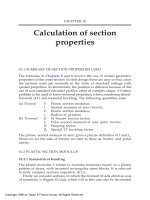
Aluminium Design and Construction - Chapter 10 pps
... are bisymmetric, radial-symmetric or skew-symmetric S coincides with G and g=0. For sections entirely composed of radiating outstand elements, such as angles and tees (‘type-R’ sections, Figure ... giving w ° =0. In all other cases, w ° is non-zero and must be calculated. Figure 10.16 compares the warping of an I-section (bisymmetric) and a zed (skew-symmetric). With the zed it is se...
Ngày tải lên: 22/07/2014, 18:22
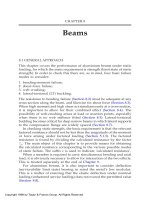
Aluminium Design and Construction - Chapter 8 doc
... p v1 =buckling stress without tension-field action (Figure 8 .11) , and v 2 =tension-field parameter (Section 8.3.6). The section of the end-post must be adequate to resist M and V simultaneously, when checked ... elastic-perfectly plastic steel-type stress-strain curve. The effect, that the actual rounded nature of the stress-strain curve has on the moment capacity, is considered by Mazz...
Ngày tải lên: 22/07/2014, 18:22
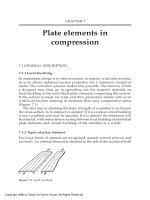
Aluminium Design and Construction - Chapter 7 pps
... element. Stress-pattern at failure, and assumed effective section. N=non-welded, W=with edge-welds. Figure 7.5 Slender outstand. Stress- pattern at failure, and assumed effective section. N=non-welded, ... outstands is similar, but with a different ß-scale (about one-third). The scatter shown in the figure results from random effects including initial out-of-flatness and shape of the st...
Ngày tải lên: 22/07/2014, 18:22

Aluminium Design and Construction - Chapter 6 pptx
... material and also non-heat-treatable material there is negligible dip at A, and k z3 =k z1 . 6.4.2 Heat-treated material Table 6.1 lists proposed k z -values for MIG-welded joints in 6xxx and 7xxx-series ... non-heat-treatable alloys, HAZ softening need only be consid- ered for work-hardened material; it is not a factor with extrusions or Figure 6.2 Typical hardness plots at a weld in h...
Ngày tải lên: 22/07/2014, 18:22
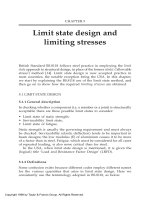
Aluminium Design and Construction - Chapter 5 pps
... All Rights Reserved. CHAPTER 5 Limit state design and limiting stresses British Standard BS. 8118 follows steel practice in employing the limit state approach to structural design, in place of ... appropriate scatter-band, with a cut-off at the limiting stress for the material. Local buckling of a thin-walled cross-section, as distinct from overall buckling of the member as a whole...
Ngày tải lên: 22/07/2014, 18:22
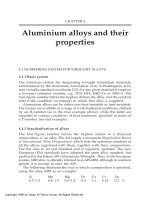
Aluminium Design and Construction - Chapter 4 pptx
... that alloy is supplied. Aluminium alloys can be either non-heat-treatable or heat-treatable. The former are available in a range of work-hardened conditions, defined by an H-number (as in the first ... of work-hardened sheet and drawn tube can be crudely expressed in terms of its hardness, the standard tempers being Table 4.1 The seven alloy series Note. NHT=non-heat-treatable, HT=heat-tr...
Ngày tải lên: 22/07/2014, 18:22
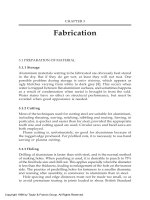
Aluminium Design and Construction - Chapter 3 potx
... for non-aeronautical use are usually in the stronger kind of 6xxx-series alloy. They can be either machined from T6-condition bar-stock, or forged and then artificially aged (T8-condition). Design data ... magnetically, the stainless being non-magnetic (if of the austenitic type). British Standard BS. 8118 calls for washers to be provided under both bolt-head and nut. With aluminium...
Ngày tải lên: 22/07/2014, 18:22
- design and construction of lpg installations
- api std 2510 design and construction of lpg installations
- api standard 2510 design and construction of lpg installations
- api std 2510 design and construction of liquefied petroleum gas installations lpg
- american petroleum institute api 2510 design and construction of lpg installations
- code of practice for design and construction
- steel rigid frames manual design and construction